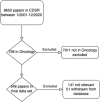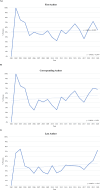A 20-year analysis of gender trends in oncology authorship in the Cochrane database of systematic reviews
- PMID: 39474110
- PMCID: PMC11518686
- DOI: 10.3389/fonc.2024.1450475
A 20-year analysis of gender trends in oncology authorship in the Cochrane database of systematic reviews
Abstract
Objectives: The objective of this study was to evaluate global longitudinal publication trends in oncology in the Cochrane Database of Systematic Reviews (CDSR) from 2001-2020.
Design: Retrospective bibliometric analysis.
Primary and secondary outcome measures: The primary outcome measures were the numbers and percentages of women as first, last, and corresponding author across all CDSR oncology publications. Additional outcomes included authorship differences between countries and percentages of women authors over time compared using the Cochran-Armitage trend test.
Results: In total, 548 articles were analyzed. Women were first authors in 52.26% (n=277) and corresponding authors in 50.75% (n=272), respectively. Women represented only 39.4% (n=210) of last authors, significantly less frequent than male counterparts (p < 0.001). The percentage of women last and corresponding authors has increased significantly in the past 20 years (p < 0.05). Countries such as the Netherlands and Australia consistently showed equitable representation in first, corresponding, and last authorship, while other countries such as Italy and China had uniformly low rates of female authorship.
Coclusions: Our results highlight patterns of gender inequity in oncology publication authorship in the CDSR from 2001-2020 at a global level. Notably, women were less likely to serve in the last author position which, independent of assigned corresponding authorship, is generally assumed in academic oncology to designate the leader of a published study. Substantive efforts to correct this disparity are needed to achieve gender parity in publicly perceived leadership in oncology publications.
Keywords: Cochrane database of systematic reviews; academic medicine; authorship; gender inequity; oncology; women in medicine.
Copyright © 2024 Levy, Samarakoon, Smith, Goo, Duthely, Van Zuilen, Huang and Pillai.
Conflict of interest statement
The authors declare that the research was conducted in the absence of any commercial or financial relationships that could be construed as a potential conflict of interest. The author(s) declared that they were an editorial board member of Frontiers, at the time of submission. This had no impact on the peer review process and the final decision.
Figures


References
-
- Krstacic JE, Carr BM, Yaligar AR, Kuruvilla AS, Helali JS, Saragossi J, et al. . Academic medicine’s glass ceiling: Author’s gender in top three medical research journals impacts probability of future publication success. PloS One. (2022) 17:e0261209. doi: 10.1371/journal.pone.0261209 - DOI - PMC - PubMed
Publication types
LinkOut - more resources
Full Text Sources
Miscellaneous

